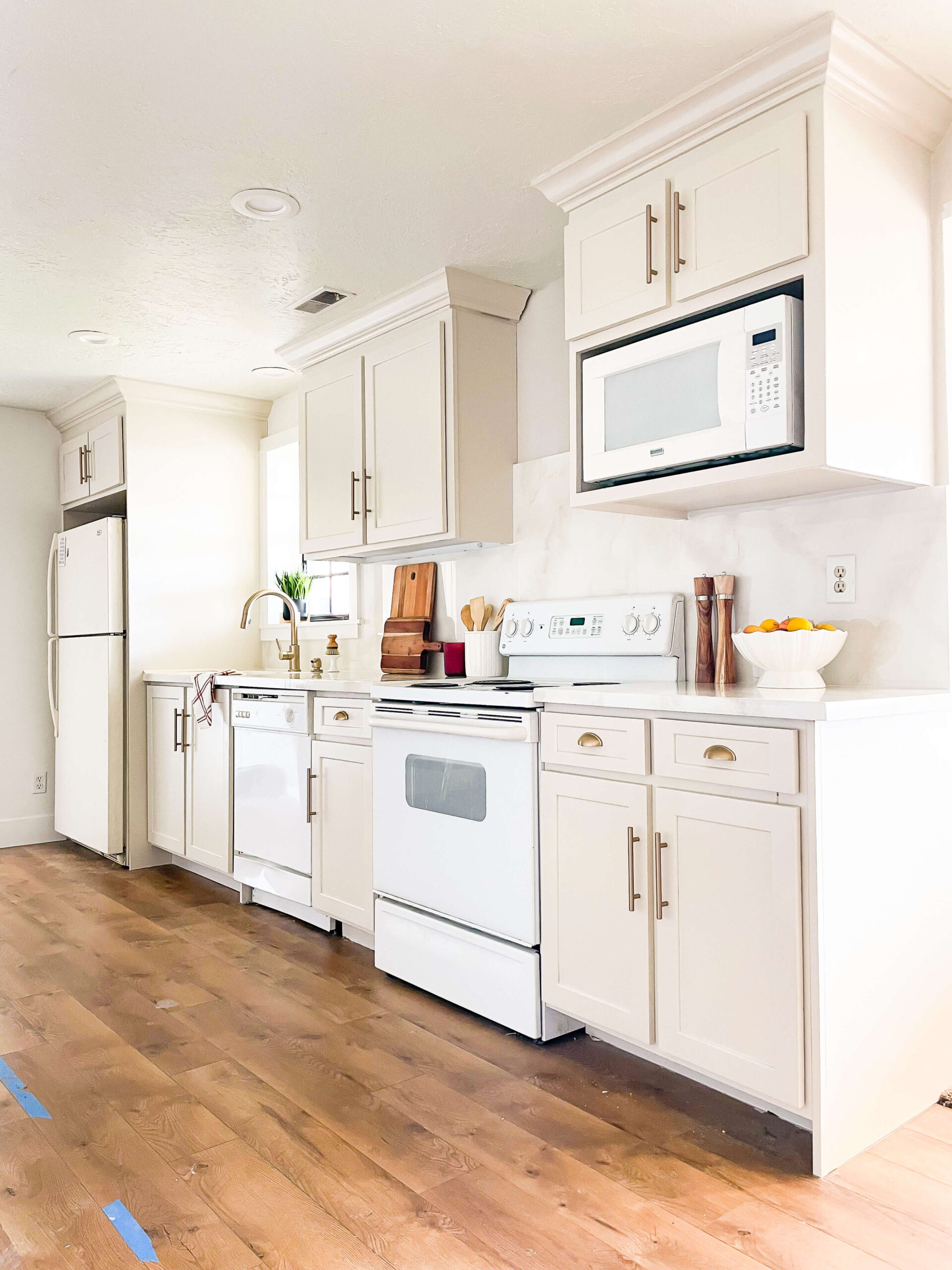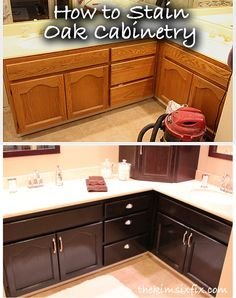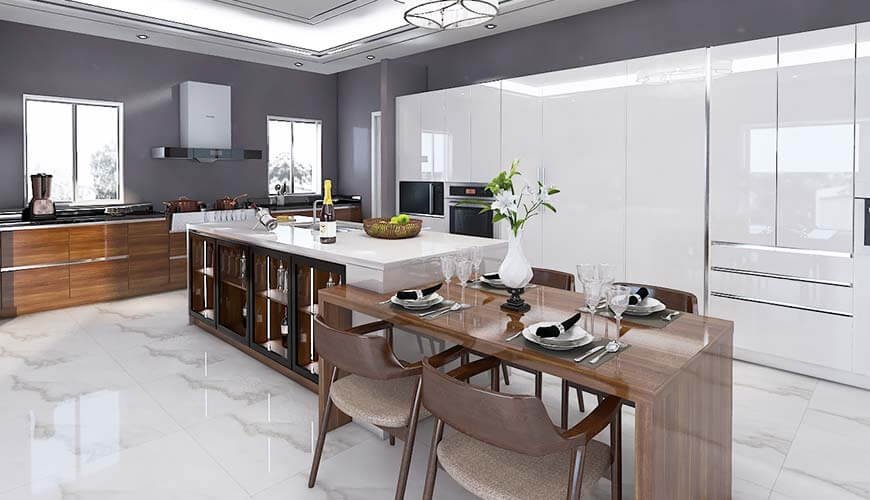Yes, kitchen cabinets can be refurbished. This can significantly enhance their appearance and functionality.
Refurbishing kitchen cabinets is a cost-effective way to update your kitchen. By repainting, refinishing, or replacing cabinet doors, you can achieve a fresh look without the expense of a complete renovation. Many homeowners opt for refurbishment as it allows for customization while retaining the existing layout.
This process also reduces waste, making it an eco-friendly choice. Whether you aim to modernize your kitchen or restore its classic charm, refurbishing offers flexibility and creativity. Proper preparation and quality materials ensure long-lasting results. With some effort, your old cabinets can look as good as new, adding value and appeal to your home.

Table of Contents
ToggleAssessing Your Cabinets
Before you start refurbishing, it’s crucial to assess your kitchen cabinets. You need to understand what you’re working with. This involves evaluating the material types and checking the current condition.
Material Types
Kitchen cabinets come in various materials. Each type requires different refurbishing methods. Here’s a quick overview:
- Solid Wood: Durable and easy to sand and paint.
- Plywood: Strong and stable, great for staining.
- MDF (Medium Density Fiberboard): Smooth surface, best for painting.
- Laminate: Requires special paint and primer.
- Metal: Needs rust-proof paint and primer.
Knowing the material helps you choose the right refurbishing technique.
Current Condition
Examine the current state of your cabinets carefully. Look for signs of wear and damage.
| Condition | Indicators |
|---|---|
| Good | Minor scratches, no structural damage |
| Moderate | Some dents, loose hinges, minor water damage |
| Poor | Major cracks, severe water damage, mold |
Good condition cabinets might only need a fresh coat of paint. Moderate condition might require some repairs. Poor condition may need a complete overhaul.
By assessing your cabinets, you determine the scope of your project. This saves time and helps in planning.

Essential Tools
Refurbishing kitchen cabinets can breathe new life into your kitchen. To get started, you need the right tools. Having both basic and specialized tools ensures a smoother process. This guide covers the essential tools you need.
Basic Tools
- Screwdrivers: Necessary for removing cabinet doors and hardware.
- Hammer: Useful for minor adjustments and repairs.
- Sandpaper: Prepares the surface for painting or staining.
- Paintbrushes: Ideal for applying paint or varnish.
- Measuring Tape: Ensures accurate measurements for cuts and fits.
Specialized Equipment
- Electric Sander: Speeds up the sanding process significantly.
- Paint Sprayer: Provides a smooth and even finish.
- Wood Filler: Fills in any dents or scratches in the wood.
- Clamps: Holds pieces in place during assembly or drying.
- Drill: Essential for making new holes for hardware or hinges.
| Tool | Purpose |
|---|---|
| Screwdrivers | Removing and installing cabinet hardware |
| Hammer | Making minor adjustments |
| Sandpaper | Smoothing surfaces for refinishing |
| Paintbrushes | Applying paint or varnish |
| Electric Sander | Quickly sands large surfaces |
Preparation Steps
Refurbishing kitchen cabinets can breathe new life into your kitchen. The process starts with thorough preparation. Proper preparation ensures a smooth and durable finish. Below are the key preparation steps for refurbishing kitchen cabinets.
Cleaning
Begin by cleaning the cabinets to remove dirt and grease. Use a gentle cleaner like a mixture of dish soap and water. Avoid harsh chemicals that could damage the surface.
- Remove all cabinet doors and hardware.
- Wipe down all surfaces with the soap solution.
- Rinse with clean water and let dry completely.
Make sure all surfaces are dry before moving on to the next step.
Sanding
Sanding is crucial for a smooth finish. Use sandpaper with 120 to 150 grit for the first pass.
- Sand all cabinet surfaces lightly to remove the old finish.
- Wipe away dust with a damp cloth.
- For a smoother surface, use finer sandpaper (220 grit).
After sanding, ensure all surfaces are free of dust.
| Step | Description |
|---|---|
| Cleaning | Remove dirt and grease with a soap solution. |
| Sanding | Lightly sand surfaces to remove old finish. |
Follow these preparation steps for a successful kitchen cabinet refurbishing project.
Choosing Paint And Finishes
Refurbishing kitchen cabinets can breathe new life into your kitchen. The right paint and finish can transform outdated cabinets into stylish focal points. Let’s explore the types of paint and finish options available for your kitchen cabinets.
Paint Types
Picking the right paint type is crucial for a lasting finish. Here are the most popular options:
- Latex Paint: Easy to clean and quick drying. Ideal for DIY projects.
- Oil-Based Paint: Durable and smooth finish. Better for high-traffic areas.
- Chalk Paint: Gives a vintage look. Requires a protective wax or topcoat.
- Milk Paint: Eco-friendly and non-toxic. Perfect for a rustic or antique style.
Finish Options
The finish of your cabinets will impact their look and durability. Here are some options to consider:
| Finish Type | Characteristics |
|---|---|
| Matte Finish | No shine, hides imperfections, needs frequent cleaning. |
| Satin Finish | Soft sheen, easy to clean, good for all styles. |
| Semi-Gloss Finish | Shiny, durable, best for high-traffic areas. |
| High-Gloss Finish | Very shiny, modern look, highlights imperfections. |
Choosing the right paint and finish is crucial for a successful cabinet refurbishment. Use this guide to make an informed decision. Your kitchen will thank you!
Application Techniques
Revamping kitchen cabinets brings new life to your space. The method of applying paint or stain greatly impacts the result. Here, we’ll cover two main techniques: brushing and spraying.
Brushing
Brushing is a classic and simple method. It requires a quality brush and patience. Brushing works well for small areas and detailed work. Here are steps for effective brushing:
- Use a high-quality brush.
- Apply thin, even coats.
- Brush in the direction of the wood grain.
- Let each coat dry fully before adding the next.
- Cost-effective.
- Ideal for small touch-ups.
- Requires minimal setup.
- Time-consuming.
- Brush marks may appear.
- Less smooth finish.
Spraying
Spraying offers a smooth and professional finish. This technique is faster and covers large areas well. Here are the steps for effective spraying:
- Use a paint sprayer.
- Practice on scrap wood first.
- Hold the sprayer 6-12 inches away from the surface.
- Apply thin, even coats.
- Allow each coat to dry completely.
- Fast application.
- Even and smooth finish.
- Covers large areas quickly.
- Requires more setup.
- Cost of equipment.
- Potential for overspray.
Choosing the right method depends on your project needs. Both techniques can yield beautiful results with proper care.
Adding New Hardware
One of the easiest ways to refurbish kitchen cabinets is by adding new hardware. This simple change can make a big difference. New hardware can give cabinets a fresh look. It also improves functionality. Let’s explore how to update handles, knobs, and hinges.
Handles And Knobs
Handles and knobs come in many styles. They can be modern, classic, or vintage. Choose a style that matches your kitchen’s theme.
- Modern: Sleek and simple designs, often in stainless steel.
- Classic: Timeless designs, usually in brass or bronze.
- Vintage: Unique designs, often with intricate details.
Replacing handles and knobs is easy. You only need a screwdriver. Follow these steps:
- Remove the old handle or knob.
- Align the new handle or knob with the holes.
- Secure it with screws.
This quick change can transform the look of your cabinets.
Hinges
Updating hinges is another way to refurbish cabinets. Old hinges can make doors creaky. New hinges can make them smooth.
There are different types of hinges:
| Type | Description |
|---|---|
| Overlay | Hides the cabinet frame for a sleek look. |
| Inset | Shows the cabinet frame for a classic look. |
| European | Offers soft-close feature for quiet closing. |
To replace hinges, follow these steps:
- Remove the old hinge from the door.
- Attach the new hinge to the door.
- Align the door with the cabinet frame.
- Screw the hinge to the frame.
New hinges can make your cabinets work like new.
Maintenance Tips
Maintaining your refurbished kitchen cabinets can make them last longer. By following simple maintenance tips, you can keep them looking new and fresh. Here are some essential tips to ensure your cabinets remain in top condition.
Regular Cleaning
Regular cleaning is crucial to keep your kitchen cabinets spotless. Use a soft cloth and mild soap to wipe down the surfaces weekly. Avoid harsh chemicals; they can damage the finish.
- Dust the cabinets weekly to prevent buildup.
- Use a soft cloth to clean spills immediately.
- For tough stains, use a mixture of baking soda and water.
Remember to clean both the inside and outside of the cabinets. This will help in maintaining their appearance and hygiene.
Damage Prevention
Preventing damage is key to preserving your refurbished cabinets. Here are some tips to help:
| Tip | Action |
|---|---|
| Use Cabinet Liners | Line the shelves with protective liners. |
| Close Doors Gently | Use soft-close hinges to avoid slamming. |
| Use Coasters | Place coasters under hot or wet items. |
By following these steps, you can prevent scratches and other damage.
Keep an eye out for any loose hinges or knobs. Tighten them as needed to avoid further damage.

Frequently Asked Questions
Can Kitchen Cabinets Be Refurbished Easily?
Yes, kitchen cabinets can be refurbished. It typically involves cleaning, sanding, painting, or staining to give them a fresh look.
What Materials Are Needed For Cabinet Refurbishment?
You will need sandpaper, paint or stain, brushes, primer, and possibly new hardware like knobs and hinges.
How Long Does Cabinet Refurbishment Take?
Refurbishing kitchen cabinets usually takes a few days. Drying times for paint or stain add to the duration.
Is Cabinet Refurbishment Cost-effective?
Yes, refurbishing is more affordable than replacing cabinets. It can significantly improve the kitchen’s appearance on a budget.
Can I Refurbish Cabinets Myself?
Yes, with the right tools and materials, DIY cabinet refurbishment is possible. It requires patience and attention to detail.
What Is The First Step In Refurbishing?
The first step is to clean the cabinets thoroughly. Remove all grease, grime, and dirt to ensure a smooth finish.
Do I Need To Remove Cabinet Doors?
Removing cabinet doors makes the refurbishment process easier. It allows for a more even and professional finish.
What Kind Of Paint Is Best For Cabinets?
Use high-quality, durable paint specifically designed for cabinets. Semi-gloss and satin finishes are popular choices.
Can Damaged Cabinets Be Refurbished?
Minor damage can be repaired before refurbishing. However, severely damaged cabinets may need replacement or professional help.
How To Choose A New Cabinet Color?
Consider your kitchen’s overall theme and lighting. Neutral colors are timeless, while bold colors can make a statement.
Conclusion
Refurbishing kitchen cabinets is a cost-effective and rewarding option. It revitalizes your space without a full renovation. With some effort, your cabinets can look brand new. Use quality materials for long-lasting results. By refurbishing, you save money and reduce waste.
Enjoy a refreshed kitchen with updated cabinets!


